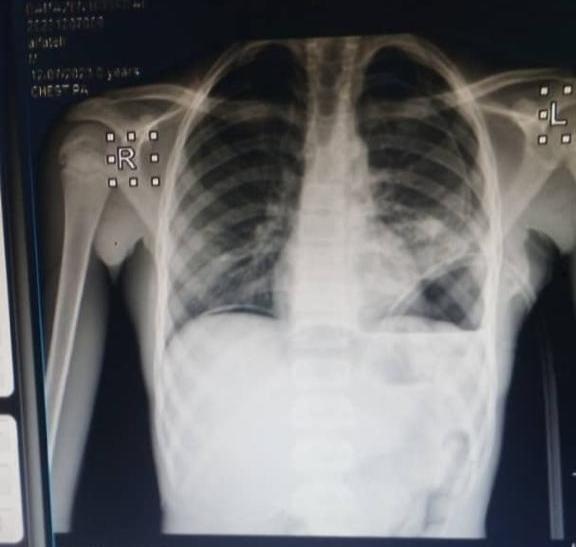Past Issues
Stab Chest with Diaphragmatic Rupture and Herniated Stomach
Ammar Abdarasol Mohamed Abdallah*
Nile College, Sudan
Corresponding Author: Ammar Abdarasol Mohamed Abdallah, Nile College, Sudan; Email: [email protected]
Received Date: October 10, 2023
Publication Date: March 08, 2024
Citation: Abdallah AAM. (2024). Stab Chest with Diaphragmatic Rupture and Herniated Stomach. Cases. 3(1):15.
Copyright: Abdallah AAM. © (2024).
ABSTRACT
This is single case report form surgical department to show the importance of early detection of herniated abdominal content and the confusion that may took place between the appearance of not well centralized chest X-ray and the appearance of herniated abdominal content into the chest cavity. The case of a 14 years old male whom was a victim of stab chest with herniated stomach, gastric injury and presence of GI content in the chest cavity. Written ethical approval was taken from both biological parents. This case has been chosen because of I interest in the complexity of the case and confusion in the final diagnosis
Keywords: Surgery case report, Stab chest, Diaphragmatic rupture, Gastric herniation, Stab in pediatric
INTRODUCTION
Stabbed chest patients and stabbed abdomen patients have always places a question whether to provide conservative management or directly perform a surgery. the presented case in this report emphasizes on the importance of having clear cut-off points that indicated whether to take the stabbed patient to surgery or not, and also emphasizes on the possibility of miss interpretation of imaging results as this may lead to delayed management or unnecessary surgeries.
Regarding literature review, one case report indicated that the presence of subscapular pain in a patient with a penetrating injury to the chest strongly suggests penetration of the diaphragm and a high risk of associated intra-abdominal injuries. This situation warrants surgical evaluation of the abdomen in the operating room. And Arterial blood gas is a better indicator of hemorrhage than hematocrit. [1]
Another case report indicates that in stable but suspicious high-risk injury patients, echocardiography and computerized tomography chest are the modalities of choice, with a sensitivity of 76.9% and a specificity of 99.7% for hemopneumopericardium [2] with these two case reports, clinical assessment and imaging studies should be used simultaneously to determine the need for surgery.
CASE REPORT
14 years old with free medical background presented to us after offered medical service in another place after a stab to the left chest (knife). Chest tube was already inserted at the e first presentation (was inserted 4 hours after the stab). The patient presented to us with shortness of breath After the stab and started to bleed, there was also sever pain around the wound, but there was loss of consciousness.
There was no syncope, hemoptysis, lower limb swelling, cough or dizziness. Systemic review revealed no vertigo, paresis or paralysis, no headache, sphenteric disturbances or decreased visual acuity. The patient is not on long term medications and of low socioeconomic status.
Examination revealed ill looking, and tachypnea patient. Respiratory rate 44 breath/minute and pulse rate is 98 neat/minute (normal volume and regular)
Lab results revealed total white cells count of 11.8, HB of 13.3, platelet count of 366, blood group of A+, negative blood film for malaria.
Abdominal ultrasound reveled gastric content in the left chest, and chest x-ray showed to air fluid level inside the left chest with the left dome of the diaphragm being upper than the usual side, the patient was not well centralized during image taking.
After days that patient were taken for laparotomy, there was gastric diaphragmatic herniation, stomach injury at the anterior wall and splenic laceration. Suction of the gastric content in the peritoneum and left side of the chest was done, also refashioning of the stomach injury was done (single repair was done, 1st layer with with continuous suturing and second layer with interrupted suturing). The diaphragm was repaired with non-absorbable suture one chest tube and one drain (in the abdomen) was inserted.
DISCUSSION The use of clinical assessment in conjunction with imaging studies should always be mandatory to conclude the decision of surgery, and not relying on clinical assessment only. In the light of this case and the literature review discussed, a conclusion is made, the development of policy or protocol that demonstrate the necessity of surgery according to the level of sensitivity of indicators used is crucial to have better indicators and unify the practice.
Figure: Before the lapartomty after the laparotomy
ETHICAL APPROVAL
Written informed ethical approval was signed by both parents of the patient.
CONSENT OF PUBLICATION
The informed consent included publication.
ACKNOWLEDGMENTS AND AUTHOR’S CONTRIBUTION
Data has been collected by a college.
CONFLICTS OF INTEREST AND COMPETING INTEREST
There is no conflict of interest and no competing interest.
FUNDING
This was out of pocket project.
DATA AVAILABILITY AND MATERIAL
The findings of this study are available within the article [and/or] its supplementary materials.
REFERENCES
Aihara R, LaMorte W. (2023). Diagnostic Laparoscopy in Penetrating Chest Trauma, Boston Medical Center. https://www.bumc.bu.edu/surgery/training/residency/teaching-conferences-rounds/trauma-case-1-stab-to-left-chest/
Kumari U, Abbas F, Shirazi Z, Hafeez N, Sarmad SF, Bangash S. (2022). Accidental Penetrating Thoracic Injury with a Screwdriver in a Child: A Case Report. J Tehran Heart Cent. 17(3):156-158.
 Abstract
Abstract  PDF
PDF
